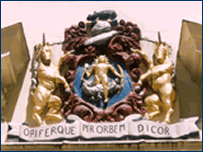Constipated? In the early 19th century, the apothecary would most likely have prescribed you calomel, or mercurous chloride, as a purgative, regardless of its toxicity. Because it worked. It was also useful as an insecticide.
This was the sort of thing being concocted at the Apothecaries’ Hall in Blackfriars, then a major center for drug manufacturing in London, says Anna Simmons, a historian of science at the Open University in Milton Keynes. It was also common for patients with chronic skin infections to walk away with a dose of arsenic, she says.
While most drug manufacturing was still shop-based, the Society of Apothecaries had set up a state-of-the-art laboratory that was a major site of chemical activity in London.

The laboratory was filled was with fires and furnaces; its steam laboratory contained vats of exotic plant juices; the mill house used steam power to grind up drugs; and there was a test room for the analysis of finished products, from plant tinctures to the mercury-based calomel.
Its customers included members of the Society, the British Navy and government organisations, while its drugs ended up in nearby St Bartholomew’s Hospital and as far away as India and Australia.
The original Hall was Cobham House, purchased in 1632 but it was destroyed in the Great Fire of London in 1666. It was rebuilt shortly thereafter and restored in 1780. Its Great Hall, Court Room and Parlour remain the same as it was after it was reconstructed between 1668 and 1670.

The Apothecaries' retail pharmacy, which had been located on the northern side of the courtyard, gained a separate entrance on Water Lane (now Black Friars Lane) in 1823. Its steps and wrought-iron railings are still evident.
Although the laboratory closed in 1922, and in spite of the dangerous products it sometimes produced, the Society of Apothecaries' activities supplying large quantities of drugs to customers throughout the world made it the first multi-national pharmeceutical company.
Source: British Society for the History of Science






Comments